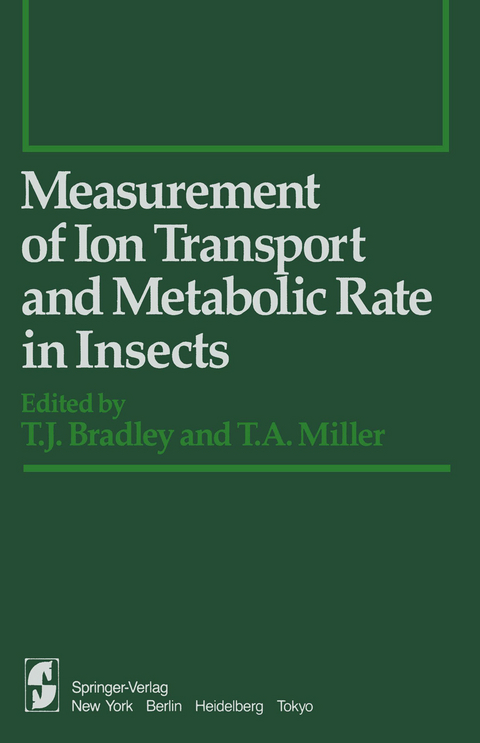
Measurement of Ion Transport and Metabolic Rate in Insects
Seiten
2011
|
Softcover reprint of the original 1st ed. 1984
Springer-Verlag New York Inc.
978-1-4613-8241-6 (ISBN)
Springer-Verlag New York Inc.
978-1-4613-8241-6 (ISBN)
Insects as a group occupy a middle ground in the biosphere between bacteria and viruses at one extreme, amphibians and mammals at the other. Therefore, techniques developed in the study of insects or in those fields concerned with the control of insect pests are often unique.
Insects as a group occupy a middle ground in the biosphere between bacteria and viruses at one extreme, amphibians and mammals at the other. The size and general nature of insects present special problems to the student of entomology. For example, many commercially available instruments are geared to measure in grams, while the forces commonly encountered in stUdying insects are in the milligram range. Therefore, techniques developed in the study of insects or in those fields concerned with the control of insect pests are often unique. Methods for measuring things are common to all sciences. Advances sometimes depend more on how something was done than on what was measured; indeed a given field often progresses from one technique to another as new methods are discovered, developed, and modified. Just as often, some of these techniques find their way into the classroom when the problems involved have been sufficiently ironed out to permit students to master the manipulations in a few laboratory periods. Many specialized techniques are confined to one specific research laboratory. Although methods may be considered commonplace where they are used, in another context even the simplest procedures may save considerable time. It is the purpose of this series (1) to report new developments in methodology, (2) to reveal sources of groups who have dealt with and solved particular entomological problems, and (3) to describe experiments which may be applicable for use in biology laboratory courses.
Insects as a group occupy a middle ground in the biosphere between bacteria and viruses at one extreme, amphibians and mammals at the other. The size and general nature of insects present special problems to the student of entomology. For example, many commercially available instruments are geared to measure in grams, while the forces commonly encountered in stUdying insects are in the milligram range. Therefore, techniques developed in the study of insects or in those fields concerned with the control of insect pests are often unique. Methods for measuring things are common to all sciences. Advances sometimes depend more on how something was done than on what was measured; indeed a given field often progresses from one technique to another as new methods are discovered, developed, and modified. Just as often, some of these techniques find their way into the classroom when the problems involved have been sufficiently ironed out to permit students to master the manipulations in a few laboratory periods. Many specialized techniques are confined to one specific research laboratory. Although methods may be considered commonplace where they are used, in another context even the simplest procedures may save considerable time. It is the purpose of this series (1) to report new developments in methodology, (2) to reveal sources of groups who have dealt with and solved particular entomological problems, and (3) to describe experiments which may be applicable for use in biology laboratory courses.
1. Introduction.- 2. In Vitro Techniques for Studies of Malpighian Tubules.- 3. Methods for the Study of Transport and Control in Insect Hindgut.- 4. The Study of Atmospheric Water Absorption.- 5. Microrespirometry in Small Tissues and Organs.- 6. Spectrophotometry and Fluorometry in Ion Transport Epithelia.- 7. Coulometric Measurement of Oxygen Consumption in Insects.- 8. Techniques for Studying Na+, K+ -ATPase.
| Reihe/Serie | Springer Series in Experimental Entomology |
|---|---|
| Zusatzinfo | 236 p. |
| Verlagsort | New York, NY |
| Sprache | englisch |
| Maße | 155 x 235 mm |
| Themenwelt | Naturwissenschaften ► Biologie ► Biochemie |
| Naturwissenschaften ► Biologie ► Ökologie / Naturschutz | |
| Naturwissenschaften ► Biologie ► Zoologie | |
| Naturwissenschaften ► Physik / Astronomie ► Angewandte Physik | |
| Technik ► Umwelttechnik / Biotechnologie | |
| Schlagworte | Epithel • Insects • Insekten • Ionentransport • Stoffwechsel • Transport • Water |
| ISBN-10 | 1-4613-8241-6 / 1461382416 |
| ISBN-13 | 978-1-4613-8241-6 / 9781461382416 |
| Zustand | Neuware |
| Haben Sie eine Frage zum Produkt? |
Mehr entdecken
aus dem Bereich
aus dem Bereich


